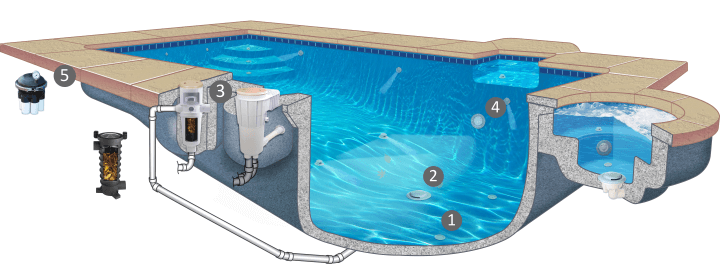How Does a Self-Cleaning Pool Work?
Owning a swimming pool can enhance your life in numerous ways, offering a refreshing escape on hot summer days, a place to exercise and unwind, and a venue for spending time with family and friends. However, maintaining a pool can be a time-consuming and often costly endeavor. To ensure a clean and sanitary pool at all times while also minimizing the time and effort spent on maintenance, many homeowners opt to install a self-cleaning pool system.
Key Components of Self-Cleaning Pools
Also known as an in-floor cleaning system or a “smart” pool, self-cleaning pools are powered by strategically placed nozzles and drains that are integrated into the pool structure. These features are designed to automate the cleaning process, ensuring that debris, algae, and bacteria are regularly and thoroughly removed from the pool. The primary components of a self-cleaning pool include:
- Pop-Up Jets. These jets are placed throughout the pool, including spots like steps, benches, and walls, and are typically installed flush with the pool surface. They pop up at set intervals and release powerful streams of water that push debris towards the main drain.
- Submersed Suction Outlet. Positioned at the deepest part of the pool, it collects debris before directing it to either the oversized pump basket or optional debris canister for filtration and removal.
- Debris Canister. This optional canister is installed on the pool deck or at the mechanical pad, where it can easily be removed and cleaned.
How the System Works
Here’s a step-by-step breakdown of how the different components of a self-cleaning pool system work together to keep your pool sparkling:
- Activation of Pop-Up Jets. The operation of a self-cleaning pool begins with the pop-up jets, which activate in sequences. The pop-up jets emerge from the pool floor and walls to spray pressurized, filtered water in a pre-determined pattern, creating currents that move debris towards the main suction outlet. Once this step is complete, the jets retract into the pool surface, where they remain nearly invisible while not in use.
- Debris Collection. The force of the water jets ensures that even stubborn debris is dislodged and directed to the main suction outlet. This continuous movement prevents contaminants such as dirt, leaves, and insects from settling and accumulating on the pool floor.
- Once debris reaches the main suction outlet, it is transported to the pump basket or debris canister. Here, the water passes through filters that capture fine particles, leaving the water clear and clean. Once the cleaning cycle is complete, simply remove and empty the pump basket or debris canister.
Benefits of Self-Cleaning Pools
The primary advantage of a self-cleaning pool is the significant reduction in maintenance time and effort. It can eliminate the need to manually vacuum the pool or frequently clean filters, as the system handles these tasks autonomously. In addition, by maintaining consistent water circulation and cleanliness, self-cleaning pools help prevent the growth of algae and bacteria, thereby enhancing the overall health and safety of the swimming environment.
The efficiency of self-cleaning systems may also help to extend the lifespan of the pool’s filtration equipment by reducing the load on the filters. This means fewer replacements and repairs, which can help you save money in the long run.
At Aqua Pool & Patio, we are proud to be the only distributor of Paramount PVR self-cleaning pool systems in Connecticut and Western Massachusetts. We have been installing Paramount systems for more than 35 years and believe the PVR is the best product on the market. This incredible system is custom designed for your unique pool shape and guaranteed to clean 99% of the entire pool, significantly reducing heating and chemical costs while ensuring that your pool remains sparkling and sanitary at all times. Contact us today to learn more about self-cleaning pool systems!




